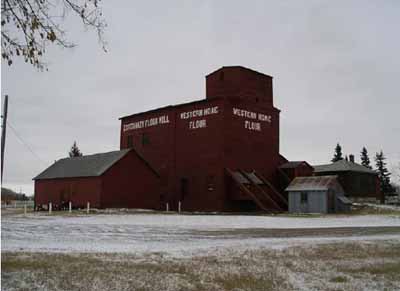Esterhazy Flour Mill National Historic Site of Canada
Esterhazy, Saskatchewan

General view
© Agence Parcs Canada / Parks Canada Agency, A. Roos, 2007.
Address :
517 Smith Dorrien Avenue, Esterhazy, Saskatchewan
Recognition Statute:
Historic Sites and Monuments Act (R.S.C., 1985, c. H-4)
Designation Date:
2009-04-20
Dates:
-
1904 to 1907
(Construction)
-
1904 to 1980
(Significant)
Event, Person, Organization:
Other Name(s):
-
Esterhazy Flour Mill
(Designation Name)
Research Report Number:
2008-038
Plaque(s)
Existing plaque: Esterhazy, Saskatchewan
Constructed between 1906 and 1907, this building is one of the few local flour mills left on the Prairies. With most of its original equipment intact, it provides a rare, complete example from a period in flour milling technology that was crucial to the grain industry. Local mills attracted settlers and businesses, spurring the establishment and development of many communities, including Esterhazy. In the early 20th century, flour mills like this one contributed to the prosperity of local and regional economies, and influenced the wider grain economy of Saskatchewan and the West.
Description of Historic Place
Esterhazy Flour Mill National Historic Site of Canada is an early 20th-century flour mill located near the western end of the village of Esterhazy, Saskatchewan. Situated on an open uneven lot, the site consists of a flour mill and attached grain elevator; three storage sheds, one with an attached office; a small engine room; and a metal-clad oil storage shed. The mill is a rare and complete illustration of flour milling technology that was crucial to the grain industry in Saskatchewan and contributed to the development of communities such as Esterhazy. Official recognition refers to the buildings on their lot.
Heritage Value
Esterhazy Flour Mill was designated a national historic site of Canada in 2009 because: the mill, which still contains almost all of its original equipment, is a rare and complete illustration of a period of flour milling technology that was crucial to the grain industry; it illustrates the importance that milling and supplying flour to communities had on local and regional economies, and on the grain economy in general during the early development of Saskatchewan and the West; milling contributed to the establishment, growth and development of many communities, Esterhazy among them, and thereby helped support immigration and settlement.
The Esterhazy Flour Mill is a rare and complete illustration of a period of flour milling technology that was crucial to the early 20th-century grain industry. Soon after the village of Esterhazy was established in 1903, interest was expressed in having a flour mill built in the community. After receiving positive feedback for the enterprise, James Saunders acquired property in the village and began the construction of a flour mill and an elevator. By 1907 the Esterhazy Flour Mill was in full operation, and by 1913, had ground 40,000 bushels of wheat. During the early development of Saskatchewan and the West, milling and supplying flour to communities was very important for local and regional economies. Such an enterprise facilitated prosperity for the community and contributed to the growth and development of villages such as Esterhazy. The presence of a successful flour mill also encouraged immigration and settlement in the area.
Source: Historic Sites and Monuments Board of Canada, Minutes, June 2008.
Character-Defining Elements
The key elements that contribute to the heritage character of this site include: its location on the western edge of the village of Esterhazy Saskatchewan; its setting in an uneven, open landscape; the three-storey flour mill of post and beam construction with large heavy timber beams running throughout the structure, attached to a grey metal-clad engine room; the grain elevator of crib construction in a sloped-shoulder design typical of early elevators, with a lean-to scale room, wooden storage bins of crib construction, and sloped-shoulder cupola; the auxiliary buildings on the site including, a small metal-clad oil shed, three single-storey storage sheds of wood frame construction, and a shed with an adjoining office; the remaining original interior configuration, features and finishes and the interior details of the flour mill and elevator including, the wood floors, simple beams and columns, and the irregularly placed windows and doors; the remaining original milling equipment and machinery including the pulleys, leather belts, bucket elevators, main drive, boilers, scouring machine, five pairs of grinding roller units, carter disc, fanning mill, wheat steamer unit, semi-automatic bagger, storage and holding bins, two bolter boxes, sifters and cream of wheat machine; the prominent location of the Historic Sites and Monuments Board of Canada plaque and cairn on the lawn in front of the flour mill; the relationship between the various buildings on the site.